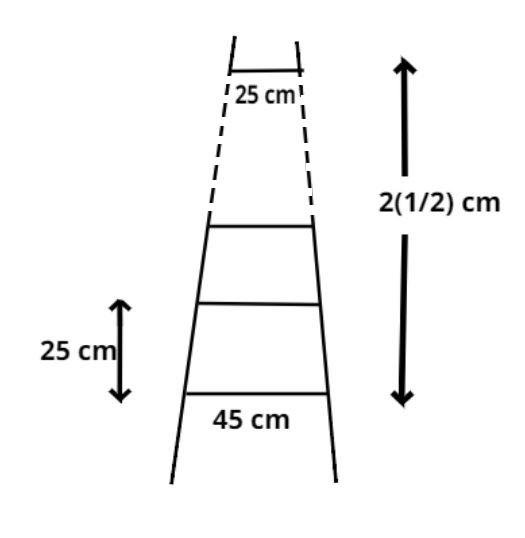
A ladder has rungs 25cm apart. The rungs decrease uniformly in length from 45 cm at the bottom to 25 cm at the top. If the top and the bottom rungs are ${\text{2}}\dfrac{1}{2}{\text{m}}$apart, then what is the length of the wood required for the rungs?


Answer
606.9k+ views
Hint: -Length of the rungs decrease uniformly therefore they will form an A.P.
According to the question it is given that the rungs are 25cm apart and the top and bottom rungs are ${\text{2}}\dfrac{1}{2}{\text{m}}$apart.
$ \Rightarrow {\text{2}}\dfrac{1}{2}m = \dfrac{5}{2}m = \dfrac{{500}}{2}cm = 250cm.\left[ {\because {\text{ 1m = 100cm}}} \right]$
$\therefore $Total number of rungs${\text{ = }}\dfrac{{{\text{Distance between total rungs}}}}{{{\text{Distance between two rungs}}}} + 1$, (plus one because of the bottom rung and thereafter all rungs are 25 cm apart).
$\therefore $Total number of rungs${\text{ = }}\dfrac{{250}}{{25}} + 1 = 11$
Now as the length of the rungs decrease uniformly therefore they will form an A.P.
So the A.P becomes $\left( {45,.................,25} \right)$
So, first term $\left( {{a_1}} \right)$of an A.P${\text{ = 45}}$, last term $\left( {{a_n}} \right)$of an A.P${\text{ = 25}}$, and number of terms in this A.P$ = 11$
Now, as we know last term of this series is written as
${a_n} = {a_1} + \left( {n - 1} \right)d$, Where d is the common difference.
$ \Rightarrow d = \dfrac{{{a_n} - {a_1}}}{n} + 1 = \dfrac{{25 - 45}}{{11}} + 1 = \dfrac{{ - 20}}{{11}} + 1 = \dfrac{{ - 9}}{{11}}$
So, the length of the rungs decrease uniformly by $\dfrac{{ - 9}}{{11}}cm$
The length of the wood required for the rungs equals the sum of all the terms of this A.P
${S_n} = 45 + \left( {45 - \dfrac{9}{{11}}} \right) + \left( {45 - \dfrac{9}{{11}} - \dfrac{9}{{11}}} \right) + .............. + 25$
Therefore sum of this A.P${\text{ = }}{{\text{S}}_n} = \dfrac{n}{2}\left( {{a_1} + {a_l}} \right)$
$ \Rightarrow {{\text{S}}_n} = \dfrac{{11}}{2}\left( {45 + 25} \right) = 11 \times 35 = 385cm$
Therefore the length of the wood required for the rungs${\text{ = 385cm}}$.
Note: -In such types of questions first find out the total numbers of rungs, then the key concept is that the length of the rungs decrease uniformly so, they will form an A.P so, the length of the wood required for the rungs equals the sum of all the terms of this A.P, so apply the formula of sum of an A.P which is stated above, we will get the required answer.
According to the question it is given that the rungs are 25cm apart and the top and bottom rungs are ${\text{2}}\dfrac{1}{2}{\text{m}}$apart.
$ \Rightarrow {\text{2}}\dfrac{1}{2}m = \dfrac{5}{2}m = \dfrac{{500}}{2}cm = 250cm.\left[ {\because {\text{ 1m = 100cm}}} \right]$
$\therefore $Total number of rungs${\text{ = }}\dfrac{{{\text{Distance between total rungs}}}}{{{\text{Distance between two rungs}}}} + 1$, (plus one because of the bottom rung and thereafter all rungs are 25 cm apart).
$\therefore $Total number of rungs${\text{ = }}\dfrac{{250}}{{25}} + 1 = 11$
Now as the length of the rungs decrease uniformly therefore they will form an A.P.
So the A.P becomes $\left( {45,.................,25} \right)$
So, first term $\left( {{a_1}} \right)$of an A.P${\text{ = 45}}$, last term $\left( {{a_n}} \right)$of an A.P${\text{ = 25}}$, and number of terms in this A.P$ = 11$
Now, as we know last term of this series is written as
${a_n} = {a_1} + \left( {n - 1} \right)d$, Where d is the common difference.
$ \Rightarrow d = \dfrac{{{a_n} - {a_1}}}{n} + 1 = \dfrac{{25 - 45}}{{11}} + 1 = \dfrac{{ - 20}}{{11}} + 1 = \dfrac{{ - 9}}{{11}}$
So, the length of the rungs decrease uniformly by $\dfrac{{ - 9}}{{11}}cm$
The length of the wood required for the rungs equals the sum of all the terms of this A.P
${S_n} = 45 + \left( {45 - \dfrac{9}{{11}}} \right) + \left( {45 - \dfrac{9}{{11}} - \dfrac{9}{{11}}} \right) + .............. + 25$
Therefore sum of this A.P${\text{ = }}{{\text{S}}_n} = \dfrac{n}{2}\left( {{a_1} + {a_l}} \right)$
$ \Rightarrow {{\text{S}}_n} = \dfrac{{11}}{2}\left( {45 + 25} \right) = 11 \times 35 = 385cm$
Therefore the length of the wood required for the rungs${\text{ = 385cm}}$.
Note: -In such types of questions first find out the total numbers of rungs, then the key concept is that the length of the rungs decrease uniformly so, they will form an A.P so, the length of the wood required for the rungs equals the sum of all the terms of this A.P, so apply the formula of sum of an A.P which is stated above, we will get the required answer.
Recently Updated Pages
Master Class 12 Business Studies: Engaging Questions & Answers for Success

Master Class 12 Economics: Engaging Questions & Answers for Success

Master Class 12 English: Engaging Questions & Answers for Success

Master Class 12 Maths: Engaging Questions & Answers for Success

Master Class 12 Social Science: Engaging Questions & Answers for Success

Master Class 12 Chemistry: Engaging Questions & Answers for Success

Trending doubts
What is meant by exothermic and endothermic reactions class 11 chemistry CBSE

Which animal has three hearts class 11 biology CBSE

10 examples of friction in our daily life

One Metric ton is equal to kg A 10000 B 1000 C 100 class 11 physics CBSE

1 Quintal is equal to a 110 kg b 10 kg c 100kg d 1000 class 11 physics CBSE

Difference Between Prokaryotic Cells and Eukaryotic Cells




